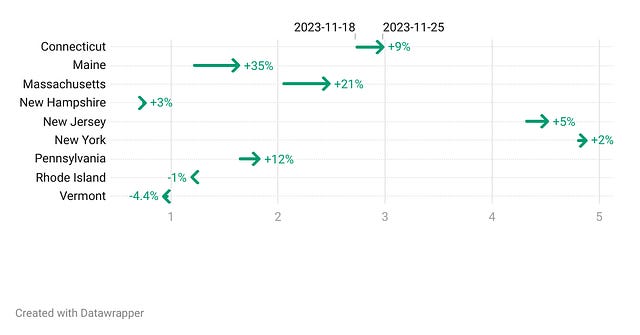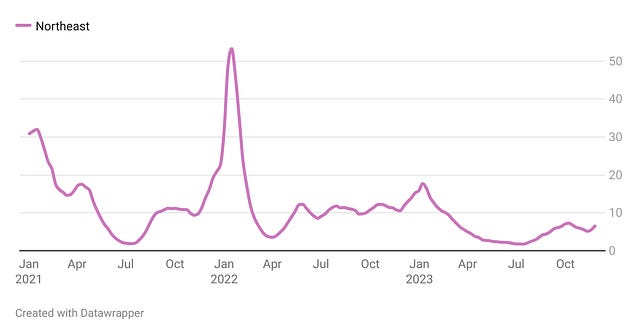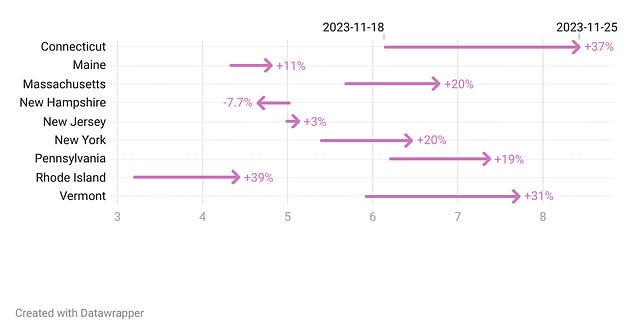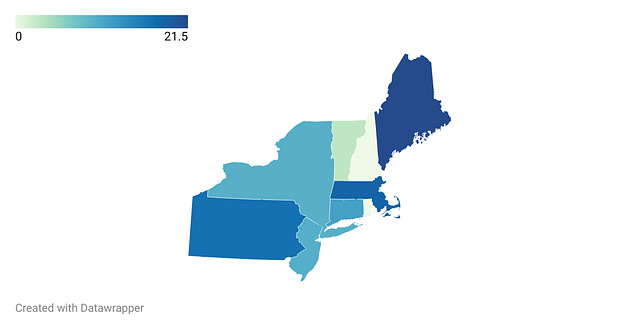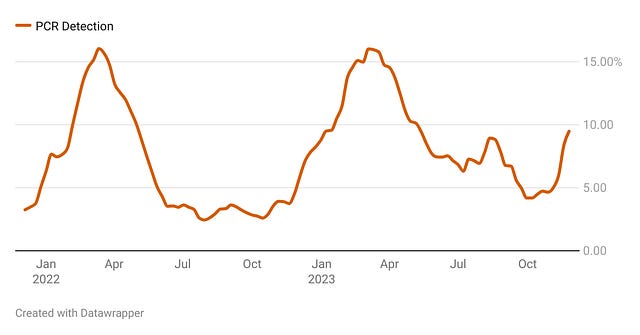Hits: 141
Welcome to the Northeast edition of Outbreak Outlook! It is only available to paid subscribers. If you wish to become a paid subscriber and access region-specific information, please click the Subscribe Now button below. Thanks for reading! -Caitlin
BY DR. CAITlIN RIVERS, December 4, 2023
(Reprinted with permission)
Respiratory diseases
Influenza-like illness
The Northeast is seeing an uptick in influenza-like illness (ILI) activity, though rates remain lower than other areas of the country. Across the Northeast region, ILI is at 3.4%, up from 3.2% last week. For reference, peak activity last season was 8.6% in this area.
Massachusetts and Maine stood out with the largest single week jumps, rising 0.4 and 0.4 percentage points to 2.5% and 1.6% respectively. New York also posted a noteworthy uptick from 4.8% to 4.9%. More modest ILI increases were seen in Connecticut, New Jersey and Pennsylvania.
New Hampshire, Rhode Island and Vermont all have low and stable levels of activity.
The arrow plots are back! As a reminder, the root of the arrow shows activity last week, the head of the arrow shows this week, and the label (e.g., 9%) is the percent change between those two weeks.
Covid-19
Covid-19 hospitalization rates in the Northeast increased quite a bit in the last week. Emergency department visits and test positivity are increasing across the region as well, which has me on alert for a winter wave.
At the state level, Connecticut saw a concerning jump, rising from 6.1 to 8.4 new admissions per 100,000. The number of new hospitalizations in Connecticut is now above this summer’s peak. Vermont also posted a sizable increase in hospitalizations, as did Pennsylvania, New York and Massachusetts.
Increases in New Jersey and New Hampshire were more modest.
RSV
RSV activity in the Northeast is increasingly quickly. Across the region, PCR test positivity rose from 11.7% to 13.9%.
States seeing the largest increases in activity include Connecticut, Vermont, and Rhode Island. Pennsylvania, Massachusetts, New York and Maine also posted sizable upticks in RSV test positive rates. New Jersey and New Hampshire rose slightly.
Overall the region is seeing an intensifying RSV trend at an important time just ahead of the holidays. Older adults and parents of infants should be cautious as holiday gathers and travel pick up in the weeks to come.
This week I am testing out maps. The darker the color, the higher the test positivity. The green color is missing data — I think next week I’ll try to make those gray. Let me know what you think!
Other Respiratory + Stomach Bugs
I’m keeping an eye on several other respiratory and stomach bugs, but overall things are looking relatively quiet at the moment in the Northeast.
- Seasonal coronavirus activity remains low in the Northeast.
- Human metapneumovirus, parainfluenza and adenovirus activity remains low.
- Norovirus activity is rising quickly. Test positivity is reaching 10%, up from less than 5% just a few weeks ago. Norovirus usually peaks around 15% in early spring, so I wouldn’t be surprised if activity keeps rising through the winter months.
Food recalls
The following foods are being recalled because they are contaminated. Please check your cupboards and throw out any of these items:
New this week:
- The cut cantaloupe recall I have been reporting on for several weeks has expanded considerably. I recommend skipping the pre-cut cantaloupe altogether for a while — including both fresh fruit and fruit cups (more info)
- Peaches, nectarines, and plums sold in bags branded as HMC Farms and Signature farms (more info)
Previously reported:
- Multiple brands of pet food – dog, cat, and catfish food (more info here and here) (Note: this poses a risk to pets and to the people that care for them, since Salmonella can be acquired via handling of the contaminated pet food and/or contact with infected animals. Several human cases, including in infants, have been tied to the pet food.)
- Tyson chicken nuggets (more info)
- Multiple brands of Apple Cinnamon Fruit Puree (more info)
If you have food allergies, you may wish to review these FDA safety alerts and USDA alerts for foods with undeclared allergens.


